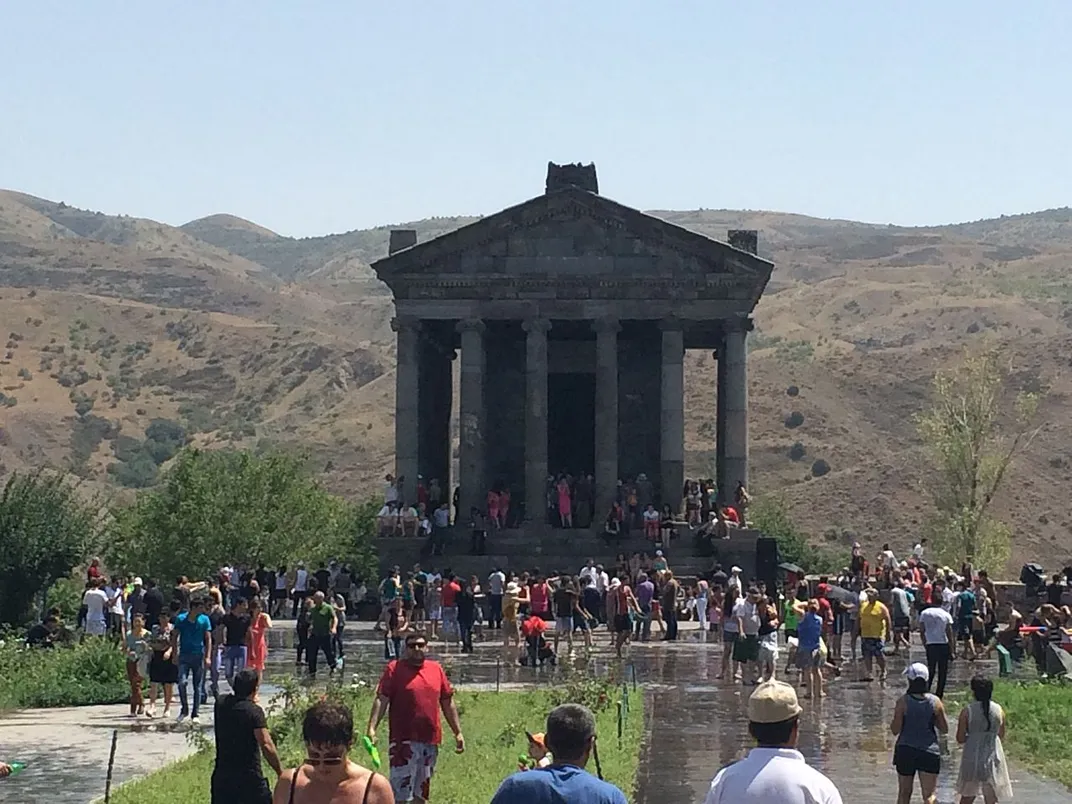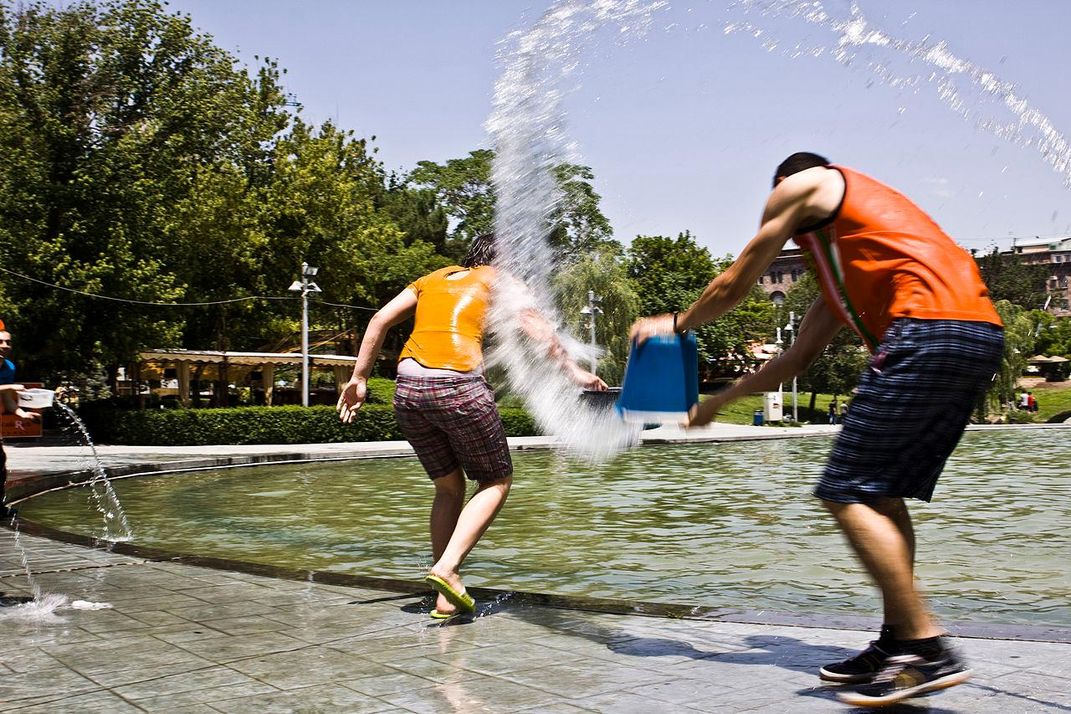The Point of Armenia’s Splashy Holiday Is Getting Wet
The ancient tradition of Vardavar attracts tourists to Armenia, but bring a change of clothes
/https://tf-cmsv2-smithsonianmag-media.s3.amazonaws.com/filer/54/4d/544d2f13-f8af-420e-8700-6c0b24cbf1d4/armenia.jpg)
Visitors to the Eurasian country of Armenia might get a soaking surprise should they be visiting on a particular Sunday in July: A bucket full of water on their head. If Vardavar seems like a holiday conceived by mischievous seven-year-olds, it’s because its chief component is drenching others with water.
From bowls and from buckets, poured from windows onto unsuspecting passerby below and between consenting dousers in village centers, water throwing on Vardavar is a holiday unique to Armenia. With roots in pagan mythology, it was later adapted by the church such that its date each summer comes 98 days—14 weeks—after Easter.
Most recently, it’s been promoted as a unique public holiday in Armenia—even one that may be attracting tourists from other countries, many of whom share the wild scenes of water-throwing among disbelieving friends back home, or on YouTube.
And while other elemental aspects of the tradition, involving fire, seems now secondary, there is still a tie to roses. Vart in Vardavar (also known as Vartavar) is the word for rose. “In Armenia it is mostly now a joyful and popular holiday just by water throwing games,” says Ruzanna Tsaturyan, a curator at the Institute of Archeology and Ethnography at the National Academy of Sciences of Armenia’s capital Yerevan, who has studied the tradition.

Vardavar was originally associated with the goddess Astghik, Tsaturyan says. As goddess of water, beauty, love and fertility, Astghik would present roses and spray rosewater intent on spreading love—and to honor Vahagn, god of fire and war. When Armenia became the first country in the world to adopt Christianity as the state religion in 301 AD, Vardavar became part of the Armenian Apostolic Church.
“Now it’s also a church holiday in Armenia. It’s included in the church calendar,” Tsaturyan says.
Celebrated as part of the Feast of the Transfiguration of the Lord on the seventh Sunday after Pentecost, it’s become one of the most popular holidays for the church, in part because the water drenching became associated with the Great Flood and the dove of Noah. Tsaturyan explained the holiday amid the hammering and hubbub in preparation for the Smithsonian Folklife Festival on the National Mall in Washington, D.C., where Vardavar was to be observed as part of a spotlight on Armenian culture, and where she paused for a moment to wonder “Will people enjoy it or will they get confused?”
That’s the case of tourists in Armenia, who happen upon the holiday, often by getting unapologetically drenched themselves. But more and more people are becoming aware of the day’s traditions. Swan Lake in the center of the country’s capital Yerevan is normally closed to waders, but on Vardavar, people are allowed to enter, bringing their buckets to douse others. The city gets into the act that day, too, by spraying big hoses on revelers. (Previously, the biggest international splash at the lake was made by Kanye West at a 2015 concert there).

While water is the enduring element of the day, the holiday once also meant lighting fires on mountaintops. “People used to make fires at high places, in hills, when they went to celebrate that holiday,” Tsaturyan says. “It is somehow connected with this summer solstice festival to have fires in higher places.”
But there’s also a religious reason for that, “because the resurrection has happened on the hill and even the gods were living above, living somewhere above, meant you should celebrate in the places high up,” she says.
High or low, Tsaturyan says, “the holiday is mostly about nature, so it’s always celebrated in nature. People go out for picnics to celebrate on the grass, in the nature, in the forest, near the spring water.” There are some traditional foods associated with Vardavar picnics as well.

“Because people going out for picnicking that day, take sheep with them to slaughter, and make stew from the lamb,” Tsaturyan says. There is also a popular Armenian pastry made for the occasion called nazook, made from flour, butter, sugar, sour cream, yeast and eggs, with a filling often made of nuts. “It’s a simple thing, but the preparation and cooking is somehow complicated and time-consuming,” she says.
A second part of the holiday in Armenia is honoring the dead the following day by visiting cemeteries, “because in Armenia it is believed they are still part of our lives and we need to honor them and to share all our joys and events with the people who have died but are still here,” she says. On that day, they leave the buckets of water behind.
But on Vardavar Sunday, all bets are off and people in Armenia fully expect to be doused.
In fact, people feel lucky when they’re hit with water, “because it’s the symbol of that day,” Tsaturyan says, “It would be unusual not to get wet at Vardavar.” However, she says, those who are “dressed to go to some special place, they always take a taxi that day, so as not to get wet.”
Otherwise, anybody is a fair target, and some people bring changes of clothes to accommodate the expected downpours.
Vardavar is, Tsaturyan says, “the only day not ashamed to get wet and to be that way in the streets and in public places.”
“And,” she adds, “it’s a unique opportunity to play with kids — the same games they are playing. Usually we have no time to play with them, because everyone is so busy, so it’s a very fun day.”
A Vardavar celebration is planned as part of the final day of the 52nd Smithsonian Folklife Festival on the National Mall in Washington, D.C. July 8.
/https://tf-cmsv2-smithsonianmag-media.s3.amazonaws.com/accounts/headshot/RogerCatlin_thumbnail.png)


/https://tf-cmsv2-smithsonianmag-media.s3.amazonaws.com/accounts/headshot/RogerCatlin_thumbnail.png)